0 引言
气候变暖毋庸置疑[1], 而南极是全球气候系统敏感的关键区[2], 在全球变暖的过程中起着不可替代的作用[3]。中山站 - Dome A断面是中国在南极的重点考察区域, 具有重要的科学意义[4]。研究表明, 在全球变暖背景下极端天气与气候事件频发[5-7], 而气候变化正在影响着极端天气事件发生的强度和频率[8], 观测到的气温极值正在发生变化[9]。南极地区尤其是东南极内陆地区自然条件恶劣, 自动气象站(AWS)分布稀少[10], 而再分析产品以格点的形式储存, 可以将AWS稀少地区的数据进行扩展, 为研究提供了便利[11], 因此分析这些再分析产品对中山站 - Dome A断面气温反演的准确性, 对利用再分析产品进行相关研究的可信度具有一定的参考意义。
全球大气再分析是利用当前最先进并固定的同化系统, 对地面、 高空、 卫星等观测资料进行同化分析, 从而获取大气及下垫面要素分析场[12]。常用的再分析产品有美国国家环境预测中心/国家大气研究中心(NCEP/NCAR)再分析产品NCEP-1、 NCEP/美国能源部(DOE)大气模式相互比对计划的再分析产品NCEP-2、 欧洲中期数值预报中心(ECMWF)的再分析产品(以下简称“欧洲再分析产品”)ERA Interim、 日本气象厅(JMA)用于实时业务的气候数据同化系统的再分析产品JCDAS[13-15]。大气再分析是衡量国家气象综合实力的有效工具, 为摆脱气象业务和科研上对欧美的依赖, 我国开始着手研发再分析产品[16]。中国气象局于2017年12月发布中国第一代全球大气和陆面再分析产品(以下简称“中国再分析产品”)逐6小时预报场CRA Interim, 它是采用美国GFS模式和GSI同化系统, 并考虑背景场卫星辐射率、 探空变分偏差等要素的订正计算后输出的再分析产品[17], 其水平分辨率为34 km, 垂直分层64层, 模式层顶为0.2 hPa。
对于欧美和日本再分析产品在不同地区的适用性已有大量研究[18-27], 研究认为ERA Interim在东南极地区的适用性优于NCEP-1、 NCEP-2及JCDAS[18], CRA Interim降水资料在中国的适用性与ERA Interim、 JRA-55整体误差水平基本一致[17], 但是中国再分析产品在中国南极考察断面的适用性评估尚未有研究。2017年ECMWF新发布了ERA5气候再分析数据集, ERA5的数据精度进一步得到提升[28], 其时间精度提高至1 h, 模式顶层提高到0.01 hPa, 水平分辨率为31 km, 垂直分层137层[29](表1)。基于东南极中山站 - Dome A断面自动气象站(中山站、 Eagle站、 Dome A)2016年2 m实测气温(平均值、 最高值、 最低值), 本文通过对比研究CRA Interim与欧洲新一代再分析数据集ERA5、 已有研究认为适用性较好的ERA Interim等三种再分析产品, 分析CRA Interim在中国东南极考察断面的适用性。
表1 三种再分析产品说明
Table 1
| 再分析产品 | 时间长度 | 同化方案 | 水平分辨率/km | 时间分辨率/h | 垂直层次/层 | 模式顶层/hPa |
|---|---|---|---|---|---|---|
| CRA Interim | 2007-01/2016-12 | GFS/GSI-3DVar | 34 | 6 | 64 | 0.2 |
| ERA Interim | 1979-01/2019-08 | IFS Cycle 31r2 | 79 | 6 | 60 | 0.1 |
| ERA5 | 1979年至今 | IFS Cycle 41r2 | 31 | 3 | 137 | 0.01 |
1 数据和方法
1.1 气象观测资料
本文使用2016年中山站(76.37°E、 69.37°S, 海拔15 m)、 Eagle站(77.07°E、 76.57°S, 海拔2 852 m)、 Dome A(77.35°E、 80.37°S, 海拔4 093 m)三个自动气象站的2 m观测气温, 数据来自于澳大利亚南极自动气象站数据集(
图1
图1
中山站 - Dome A断面自动气象站分布(左上角小图中ZS、 E、 D分别为中山站、 Eagle站、 Dome A)
Fig.1
The automatic weather stations along the traverse route from Zhongshan Station to Dome A (ZS, E, and D are abbreviations of Zhongshan Station, Eagle Station, and Dome A, respectively)
1.2 再分析产品
CRA Interim的水平分辨率为0.3125°×0.3125°, 据此欧洲再分析产品(ERA Interim和ERA5)选用与CRA Interim水平分辨率最相近的0.25°×0.25°。三种再分析产品均采用高水平分辨率, 这使三个AWS位于不同格点, 确保插值到站点的气温彼此独立。鉴于CRA Interim的时间分辨率为6 h, 为保持资料的一致性, 三种再分析产品统一采用6 h的时间分辨率。CRA Interim数据由中国气象局提供, ERA Interim和ERA5数据均在ECMWF(
1.3 方法
中山站 - Dome A断面地形相对平缓, 大部分插值方法均适用于此断面[33], 其中反距离加权插值法(IDW)综合了临近点及趋势面分析的渐变特点, 适用于均匀格点的插值。再分析产品格点均匀分布, 因此利用IDW方法将再分析数据插值到AWS所在的经纬度, 并对插值后的数据与实测数据进行均方根误差(RMSE)、 偏差(MB)以及解释方差百分率R2的计算。R2越接近1, 再分析产品对实测气温的反演效果越好; RMSE表征两组数据的离散程度; MB定义为实测数据与再分析数据之差, 表示再分析数据与实测数据之间的偏离程度, RMSE和MB数值越小, 代表两组数据的一致性越好。
2 结果与讨论
2.1 CRA Interim与ERA Interim、 ERA5的对比分析
欧洲的两种再分析产品(ERA Interim和ERA5)对东南极气温反演的偏差基本相当, 三种再分析产品对东南极中山站 - Dome A断面实测数据的解释方差均大于69.0%(图2), 总体来说再分析产品可以反演出断面实测气温。在中山站 - Dome A整个断面上, 再分析产品对日均值的拟合效果优于日极值且适用性呈现明显的地区差异: 位于冰盖边缘的中山站适用性最好, 位于冰盖内陆的Dome A次之, 与中山站和Dome A相比, 再分析产品对Eagle站气温的反演能力明显偏差。三种再分析产品对中山站日均温和最高温的反演均呈正偏差[图3(a)和(b)], ERA5对中山站最低温的反演呈现负偏差[图3(c)], 与欧洲再分析产品不同, CRA Interim对中山站最低温的反演呈现明显的正偏差; 中国和欧洲再分析产品对Eagle站气温的反演呈现负偏差且趋势基本相同[图3(d)和(f)]; 再分析产品对Dome A日均值和最低温的反演均以负偏差为主[图3(g)和(h)], 欧洲再分析产品对Dome A最高温的反演呈现正偏差, 但CRA Interim对最高温的反演呈现负偏差[图3(i)]。
图2
图2
三种再分析产品反演2016年实测气温的R2和RMSE
Fig.2
Explained variance (R2) and RMSE between the three reanalysis products and observed air temperatures in 2016
图3
图3
三种再分析产品与2016年实测气温的偏差
Fig.3
Daily bias (℃) between CRA Interim, ERA Interim, ERA5 and field observations in 2016 for mean (a, d, g), maximum (b, e, h) and minimum (c, f, i) air temperature at Zhongshan Station (a, b, c), Eagle Station (d, e, f) and Dome A (g, h, i)
在东南极中山站 - Dome A整个断面上, 三种再分析产品对日均值的反演均呈现负偏差, 其中CRA Interim的反演偏差为-1.3 ℃, ERA Interim的反演偏差为-1.1 ℃, ERA5的反演偏差为-1.0 ℃; CRA Interim对最高温的反演呈现负偏差-1.8 ℃, ERA Interim和ERA5则呈现正偏差0.5 ℃和 0.8 ℃; CRA Interim对中山站 - Dome A断面最低温的反演偏差为-0.5 ℃, 相较于ERA Interim和ERA5偏差(-2.3 ℃和-3.7 ℃)较小, 但RMSE较欧洲再分析产品大, 总体来说中国再分析产品与欧洲再分析产品在东南极中山站 - Dome A断面的适用水平相当。CRA Interim对中山站日均温、 最高温、 最低温的解释方差分别为90.5%、 93.9%、 85.5%, 而对Eagle站气温的解释方差分别为71.1%、 70.5%、 69.6%, CRA Interim在中山站的适用性明显优于Eagle站, 其在东南极中山站 - Dome A断面的适用性存在明显的地区差异。欧洲再分析产品与CRA Interim类似, 在中山站 - Dome A断面适用性表现出明显的地区差异, ERA Interim和ERA5对Eagle站气温的解释方差明显低于中山站和Dome A。CRA Interim对东南极中山站 - Dome A断面日均值、 最高温、 最低温的解释方差分别为83.1%、 82.7%、 76.8%, ERA Interim对应的解释方差为90.3%、 84.1%、 87.9%, ERA5为89.6%、 85.3%、 86.7%。与欧洲再分析产品相比, CRA Interim对最低温反演的准确性偏低, 其解释方差较ERA Interim和ERA5分别偏低11.1%和9.9%。NCEP-1、 NCEP-2作为第二代再分析产品, 其对中山站 - Dome A断面气温日均值的解释方差分别为81.5%和73.7%[16], 与NCEP系列产品相比, CRA Interim在中山站 - Dome A断面的适用性(解释方差为83.1%)较好, CRA Interim在中山站 - Dome A断面的适用性介于第二代(NCEP-2)和第三代(ERA Interim)再分析产品之间。这可能是因为CRA Interim再分析产品采用模式所输入的资料, 在ERA Interim输入产品的基础上增加了近年最新发布的各种重处理卫星产品, 以替换原来的同期实时业务产品。而重处理卫星产品有以下优势:
再分析产品可解释的月方差也表现出明显的地区差异(图4)。中国和欧洲再分析产品对中山站气温的反演优于Eagle站和Dome A, CRA Interim对Eagle 站4 - 7月气温的解释方差低于20.0%, 其中对Eagle 站7月最高温的解释方差仅有3.7%, 对5月和10月最低温的解释方差仅有2.2%和2.1%; CRA Interim对Dome A 站4 - 9月日均值和最低温反演的RMSE高于欧洲再分析产品, 相应的RMSE分别为11.7 ℃、 10.1 ℃、 11.7 ℃、 12.5 ℃、 10.8 ℃、 11.3 ℃; CRA Interim对中山站 - Dome A断面11月最低温的解释方差仅有1.0%。欧洲两种再分析产品可解释的月方差趋势相同, 与CRA Interim相似, 欧洲再分析产品对4 - 6月气温反演的准确性较其他月份差, 其中ERA Interim对Dome A 4月最高温的解释方差仅有5.2%。
图4
图4
三种再分析产品的月度解释方差
Fig.4
Monthly explained variance by CRA Interim, ERA Interim and ERA5 for mean (a, d, g), maximum (b, e, h), minimum (c, f, i) air temperature at Zhongshan Station (a, b, c), Eagle Station (d, e, f) and Dome A (g, h, i)
三种再分析产品对中山站 - Dome A断面气温反演的准确性存在季节差异(表2)。CRA Interim对春、 夏、 秋、 冬季中山站 - Dome A断面气温的解释方差分别为43.5%、 50.8%、 43.8%和29.2%; ERA Interim为54.7%、 56.2%、 61.8%和52.3%; ERA5为56.1%、 63.5%、 56.8%和45.1%。与CRA Interim类似, 欧洲两种再分析产品对冬季温度的反演效果最差, 但是与在其他季节适用性的差异不如CRA Interim明显。CRA Interim和ERA5对夏季气温的反演效果最好, 对夏季日均值的解释方差分别为55.3%和68.3%; ERA Interim在秋季的适用性最好, 对日均值的解释方差为72.0%; 三种再分析产品在冬季的适用性最差, 其中CRA Interim对冬季最低温的解释方差仅有24.6%。再分析产品对季节温度的反演存在地区差异(图5), 整体来说中国和欧洲再分析产品对中山站季节气温反演准确性较高, 对Eagle站气温反演能力偏差, 三种再分析产品中ERA Interim对Eagle站气温反演的准确性最好。再分析产品对中山站夏季气温模拟最好, 对冬季气温的模拟准确性最低, CRA Interim、 ERA Interim和ERA5可解释中山站夏季气温的77.9%、 85.5%和88.5%, 冬季气温的34.6%、 60.6%和55.9%。再分析产品对Eagle站气温的反演偏差较大, CRA Interim对Eagle站夏季气温的解释方差仅有20.4%, 欧洲再分析产品对Eagle站季节气温解释方差约为30.0%, 相较于中山站准确性大大降低。ERA5对Dome A季节气温的反演效果最好(解释方差为53.4%), 相较于欧洲再分析产品, CRA Interim对Dome A气温的解释方差约低15.0%。
表2 三种再分析产品与实测气温在各季节的RMSE、 MB及R2
Table 2
| 再分析产品 | 季节 | 平均气温Tmean | 最高气温Tmax | 最低气温Tmin | ||||||||
|---|---|---|---|---|---|---|---|---|---|---|---|---|
| RMSE/℃ | MB/℃ | R2/% | RMSE/℃ | MB/℃ | R2/% | RMSE/℃ | MB/℃ | R2/% | ||||
| CRA Interim | 春 | 6.6 | -1.3 | 44.9 | 6.7 | -1.5 | 49.7 | 6.9 | -0.8 | 35.8 | ||
| 夏 | 7.5 | -3.0 | 55.3 | 7.5 | -2.6 | 52.2 | 7.6 | -2.8 | 45.0 | |||
| 秋 | 6.7 | -1.9 | 46.5 | 8.3 | -1.3 | 47.9 | 6.7 | -1.2 | 36.9 | |||
| 冬 | 4.4 | 1.0 | 31.9 | 6.4 | 0.8 | 31.0 | 5.0 | 2.9 | 24.6 | |||
| ERA Interim | 春 | 3.7 | -0.2 | 61.4 | 5.5 | 1.8 | 45.5 | 4.6 | -1.8 | 57.1 | ||
| 夏 | 4.3 | -1.1 | 62.7 | 5.8 | 0.3 | 47.8 | 5.5 | -3.4 | 58.0 | |||
| 秋 | 4.7 | -1.8 | 72.0 | 7.0 | 0.5 | 50.7 | 5.9 | -3.8 | 62.8 | |||
| 冬 | 3.9 | -0.9 | 69.3 | 5.3 | 0.9 | 36.0 | 4.7 | -2.2 | 60.5 | |||
| ERA5 | 春 | 3.6 | -1.1 | 59.6 | 4.9 | 0.6 | 53.4 | 5.1 | -3.6 | 55.2 | ||
| 夏 | 4.4 | -2.3 | 68.3 | 5.3 | -0.6 | 59.2 | 6.6 | -5.1 | 62.8 | |||
| 秋 | 4.3 | -1.1 | 65.3 | 7.0 | 1.5 | 47.5 | 5.7 | -4.6 | 57.5 | |||
| 冬 | 3.1 | 0.4 | 55.9 | 5.9 | 3.2 | 31.2 | 3.2 | -1.6 | 48.1 | |||
图5
图5
三种再分析产品在各季节的解释方差
Fig.5
Seasonal explained variance by CRA Interim, ERA Interim and ERA5 for mean (a, d, g), maximum (b, e, h), minimum (c, f, i) air temperature at Zhongshan Station (a, b, c), Eagle Station (d, e, f) and Dome A (g, h, i)
2.2 再分析产品反演极端天气事件的个例分析
极端天气事件是指某个异常天气变量值的发生, 该值高于(或低于)该变量观测值区间的上限(或下限)端附近的某一阈值[34]。本文选用基于平均值的2倍标准差进行极端事件的判断, 2016年共有6次极端低温事件和3次极端高温事件。
再分析产品对极端气温的反演存在一定的误差。极端低温事件发生时, CRA Interim与欧洲再分析产品(ERA Interim和ERA5)可以反演出降温过程, 但反演的温度较实测数据偏高, CRA Interim、 ERA Interim和ERA5对极端低温事件发生时气温的反演偏差分别为-3.6 ℃、 -5.2 ℃、 -7.9 ℃(表3), RMSE分别为6.8 ℃、 5.3 ℃、 5.1 ℃; 极端高温事件发生时, CRA Interim、 ERA Interim、 ERA5对极端高温模拟的反演偏差分别为-2.7 ℃、 0.7 ℃、 -0.5 ℃, RMSE分别为8.5 ℃、 6.9 ℃、 6.2 ℃, 其中ERA5对极端高温的反演效果最好。ERA5、 ERA Interim对极端低温事件发生时最低气温的解释方差为87.3%和76.9%, CRA Interim的解释方差为46.1%; ERA Interim、 ERA5对极端高温事件发生时最高温的解释方差为73.6%和65.1%, CRA Interim的解释方差为59.9%。中国再分析产品对极端气温变化的敏感性较欧洲再分析产品弱。因缺少CRA Interim高空资料, 本文仅利用地面资料对极端天气过程进行分析。
表3 三种再分析产品对极端事件反演的RMSE、 MB及R2
Table 3
| 极端事件 | 再分析产品 | 平均气温Tmean | 最高气温Tmax | 最低气温Tmin | ||||||||
|---|---|---|---|---|---|---|---|---|---|---|---|---|
| RMSE/℃ | MB/℃ | R2/% | RMSE/℃ | MB/℃ | R2/% | RMSE/℃ | MB/℃ | R2/% | ||||
| 极端低温 | CRA Interim | 7.3 | -3.5 | 47.1 | 6.8 | 2.2 | 45.2 | 6.8 | -3.6 | 46.1 | ||
| ERA Interim | 3.9 | -2.1 | 60.5 | 5.3 | -0.6 | 40.0 | 5.3 | -5.2 | 76.9 | |||
| ERA5 | 4.5 | -2.9 | 56.9 | 5.1 | -1.2 | 44.5 | 5.1 | -7.9 | 87.3 | |||
| 极端高温 | CRA Interim | 7.5 | -3.3 | 57.4 | 8.5 | -2.7 | 59.9 | 7.5 | -3.5 | 32.3 | ||
| ERA Interim | 4.9 | -1.2 | 65.7 | 6.9 | 0.7 | 65.1 | 4.8 | -2.7 | 65.5 | |||
| ERA5 | 4.6 | -2.3 | 70.6 | 6.2 | -0.5 | 73.6 | 5.9 | -5.2 | 64.2 | |||
东南极中山站 - Dome A断面在2016年9月3日 - 13日发生极端低温过程, 此过程最为剧烈且持续时间最长, 本文选取此次过程对CRA Interim反演极端低温事件的能力进行分析。在此次极端低温过程中, 三个AWS中以中山站降温最为明显, 极端低温事件发生前中山站气温为-24.2 ℃, 9月7日出现-44.0 ℃的极端低温, 这同时也是2016年实测最低温度。极端低温事件发生前, Dome A和Eagle站处于偏南风的控制下[图6(a)], 中山站处于偏东风的控制下, 南风携带了南半球高纬度的冷空气使Eagle站和Dome A气温下降, 中山站在冷高压的控制下[图7(a)], 且极端事件发生时中山站的风向转为东南风[图6(b)], 这导致了中山站气温迅速下降。随着系统发展移动, 控制断面的冷高压变为暖低压, 气温逐渐回升。CRA Interim可以反演出极端低温事件发生时地面系统的演变和AWS温度的变化, 但对中山站 - Dome A断面, 尤其是中山站和Dome A风场的反演存在一定偏差。极端低温事件结束时, CRA Interim反演断面仍处于南风的控制下[图6(c)], 南风携带的高纬度冷空气会导致断面气温持续下降, 但此时极端过程已经结束, CRA Interim并未准确反演出中山站 - Dome A断面在极端低温过程发生时风场的变化。
图6
图6
极端低温事件发生前、 中、 后的10 m风场
Fig.6
The 10-m wind fields at the three automatic weather stations before (a), at (b) and after (c) the extreme low temperature event, i.e., Sept.3 - Sept.6, Sept.7 - Sept.10, and Sept.11 - Sept.13
图7
图7
极端低温事件发生前、 中、 后的地面温压场
Fig.7
Surface temperature fields (left) and pressure fields (right) for the three automatic weather stations (AWS) before (a, b), at (c, d) and after (e, f) the extreme low temperature event, i.e., Sept.3 - Sept.6, Sept.7 - Sept.10, and Sept.11 - Sept.13
2016年7月25日 - 8月6日发生在东南极中山站 - Dome A断面的极端高温过程升温最为明显, 因此选取此次事件进行CRA Interim对极端高温事件反演能力的评估。此次极端高温事件以Eagle站升温最为明显, 位于冰盖内陆的Dome A实测气温从-67.8 ℃升至-48.7 ℃, 升温幅度达19.1 ℃。极端高温事件发生前, 中山站 - Dome A断面10 m风向以北风为主[图8(a)], 北风携带了南极低纬的暖空气, 且极端高温事件发生时断面南侧存在一个暖舌[图9(b)], 此暖舌为极端事件发生前存在其南侧的暖低压发展而成, 其向中山站 - Dome A断面输送暖气流引起气温上升。随着系统的发展, Eagle站和Dome A处于西风的控制下[图8(c)], 冷高压开始控制断面[图9(c)], 气温下降, 极端高温事件结束。此次极端高温事件Eagle站和Dome A实测气温上升明显, 但CRA Interim反演的温度场中并未显示出Eagle站和Dome A的升温幅度, 且CRA Interim反演的极端高温事件结束后的风场显示中山站处于北风携带的低纬暖湿气流的控制下[图8(c)], 这会导致中山站气温继续升高, 但实际极端高温过程已经结束。相关研究表明再分析产品对强气流尤其是沿岸地区的模拟准确性较低[35], CRA Interim与其他再分析产品类似, 对中山站 - Dome A断面尤其是中山站风场的反演存在一定偏差。
图8
图8
极端高温事件发生前、 中、 后的10 m风场
Fig.8
The 10-m wind fields at the three automatic weather stations before (a), at (b) and after (c) the extreme high temperature event, i.e., Jul. 25 - Jul. 29, Jul. 30 - Aug. 2, and Aug. 3 - Aug. 6
图9
图9
极端高温事件发生前、 中、 后的地面温压场
Fig.9
Surface temperature fields (left) and pressure fields (right) for the three automatic weather stations (AWS) before (a, b), at (c, d) and after (e, f) the extreme high temperature event, i.e., Jul. 25 - Jul. 29, Jul. 30 - Aug. 2, and Aug. 3 - Aug. 6
3 结论
通过中国再分析产品(CRA Interim)与中国在南极考察断面中山站 - Dome A气象站2 m实测气温、 欧洲再分析产品(ERA Interim和ERA5)的对比分析, 可以得出如下结论:
(1) 中国和欧洲再分析产品都能够反演出东南极中山站 - Dome A断面气温的变化, 但是作为多资料融合的替代产品, 三种再分析产品皆不可避免地呈现一定的偏差。CRA Interim、 ERA Interim和ERA5对日均温的解释方差分别为83.1%、 90.3%、 89.6%, 对最高温的解释方差分别为82.7%、 84.1%、 85.3%, 对最低温的解释方差分别为76.8%、 87.9%、 86.7%。三种再分析产品对日均温和最低温的反演均呈现负偏差, 对日均温的反演偏差分别为-1.3 ℃、 -1.1 ℃、 -1.0 ℃, 对最低温的反演偏差分别为-0.5 ℃、 -2.3 ℃、 -3.7 ℃。对最高温的反演, CRA Interim呈现负偏差, 欧洲两种再分析产品呈现正偏差。
(2) 中国和欧洲再分析产品对东南极中山站 - Dome A断面气温的反演存在季节差异。CRA Interim及ERA5在夏季的适用性最好, ERA Interim在秋季的适用性最好。与欧洲再分析产品相比, CRA Interim对冬季气温的解释方差较其他季节的解释方差变化更为明显。
(3) 中国和欧洲再分析产品对东南极中山站 - Dome A断面气温的反演存在区域性差异。中国再分析产品对中山站、 Eagle站、 Dome A气温的解释方差分别为88.4%、 70.4%和80.9%。欧洲再分析产品同样对位于南极冰盖边缘的中山站气温的反演最好, 位于冰盖内陆的Dome A次之, 对Eagle站气温反演偏差较大。
(4) CRA Interim、 ERA Interim、 ERA5对极端低温事件发生时最低温的解释方差分别为46.1%、 76.9%、 87.3%, 极端高温事件发生时最高温的解释方差分别为59.9%、 65.1%、 73.6%, ERA5对极端事件发生时极端气温的反演较为准确。中国再分析产品反演出2016年9月3日 - 13日极端低温事件发生的原因为中山站 - Dome A断面受冷高压的控制, 2016年7月25日 - 8月6日极端高温事件的发生源于地面暖低压及中山站 - Dome A断面南侧一个暖舌的存在, 但CRA Interim未能反演出极端高温事件发生时Eagle站和Dome A气温的变化, 且对极端天气发生时中山站 - Dome A断面尤其是中山站风场的反演存在偏差。
CRA Interim作为中国的第一代全球大气再分析产品能够反演出东南极地区的气温变化。但是, 对于极端低温或者高温事件的反演方面, 与欧洲再分析产品尤其是ERA5资料相比, 存在一定差距。中国再分析产品可在如下方面进行提升:
参考文献
Intergovernmental panel on climate change
[J].
Polar atmospheric sciences expedition and research on global change
[J].
极地大气科学考察与全球变化
[J].
Antarctic: the thermometer of global climate
[J].
南极: 全球气候变暖的“寒暑表”
[J].
Spatial variability of surface mass balance along a traverse route from Zhongshan Station to Dome A, Antarctica
[J].
IPCC special report on managing the risks of extreme events and disasters to advance climate change adaptation (SREX)
[J].
Explaining extreme events of 2014 from a climate perspective
[J].
Increase of extreme events in a warming world
[J].
Framing the way to relate climate extremes to climate change
[J].
An introduction to trends in extreme weather and climate events: observations, socioeconomic impacts, terrestrial ecological impacts, and model projections
[J].
Analyses on the air and snow temperatures near ground with observations of an AWS at Dome A, the summit of Antarctic Plateau
[J].
东南极Dome A近地面气温及雪层温度的观测研究
[J].
Comparison of ERA-40, ERA-Interim and NCEP/NCAR reanalysis data with observed surface air temperatures over Ireland
[J].
The ERA-Interim reanalysis: configuration and performance of the data assimilation system
[J].
Evaluation of multireanalysis products with in situ observations over the Tibetan Plateau
[J].
Accuracy of NCEP/NCAR reanalyses and ECMWF analyses in the lower stratosphere over Antarctica in 2005
[J].
A tropospheric assessment of the ERA-
Collection and pre-processing of satellite remote-sensing data in CRA-40 (CMA’s global atmospheric ReAnalysis)
[J].
我国全球大气再分析(CRA-40)卫星遥感资料的收集和预处理
[J].
Research on the applicability of precipitation reanalysis data in CRA-Interim of climate and weather characters in China
[D].
中国大气再分析资料降水产品在天气和气候中的适用性研究
[D].
Assessment of air temperatures from different meteorological reanalyses for the East Antarctic region between Zhongshan and Dome A
[J].
不同再分析气温在东南极中山站 - Dome A断面的适用性评价
[J].
Comparison of river basin hydrometeorology in ERA-Interim and ERA-40 reanalyses with observations
[J/OL].
A one-year experimental Arctic reanalysis and comparisons with ERA-40 and NCEP/NCAR reanalyses
[J].
Comparison of products from ERA-40, NCEP-2, and CRU with station data for summer precipitation over China
[J].
Evaluation of NCEP-CFSR, NCEP-NCAR, ERA-Interim, and ERA-40 reanalysis datasets against independent sounding observations over the Tibetan Plateau
[J].
The applicability of ERA-Interim land surface temperature dataset to map the permafrost distribution over the Tibetan Plateau
[J].
ERA-Interim地表温度数据集在青藏高原冻土分布制图应用的适用性评估
[J].
Comparative analyses of geopotential height and wind field from multiple reanalysis data over the Tibetan Plateau
[J].
青藏高原地区多套位势高度和风场再分析资料的对比分析
[J].
Variation of the maximum and minimum air temperatures along the traverse route from Zhongshan to Kunlun Station, East Antarctica
[J].
东南极中山站 - 昆仑站断面最高和最低气温变化特征
[J].
Applicability analysis of various reanalyzed land surface temperature datasets in China
[J].
多种再分析地表温度资料在中国区域的适用性分析
[J].
Can temperature extremes in East Antarctica be replicated from ERA Interim reanalysis?
[J].
Evaluation of global horizontal irradiance estimates from ERA5 and COSMO-REA6 reanalyses using ground and satellite-based data
[J].
ERA5: the new champion of wind power modelling?
[J].
Assessing and improving the quality of unattended radiation observations in Antarctica
[J].
Correction of snow accumulation impacted on air temperature from automatic weather station on the Antarctic ice sheet
[J].
积雪对南极冰盖自动气象站气温观测影响的研究
[J].
An assessment of recent global atmospheric reanalyses for Antarctic near surface air temperature
[J].
Comparison of interpolation methods in constructing Antarctic ice sheet DEM
[J].
几种插值方法在构建南极冰盖DEM中的比较
[J].
Changes in weather and climate extremes
[J].
极端天气和气候事件的变化
[J].





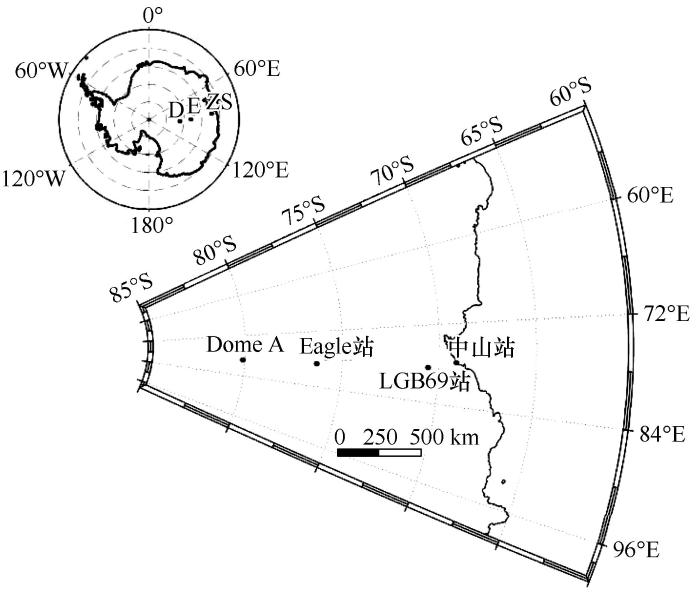

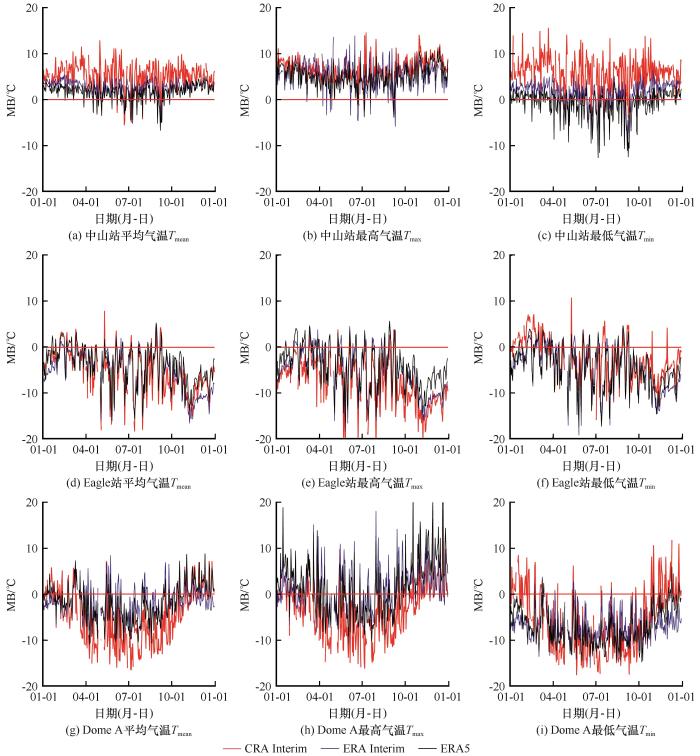
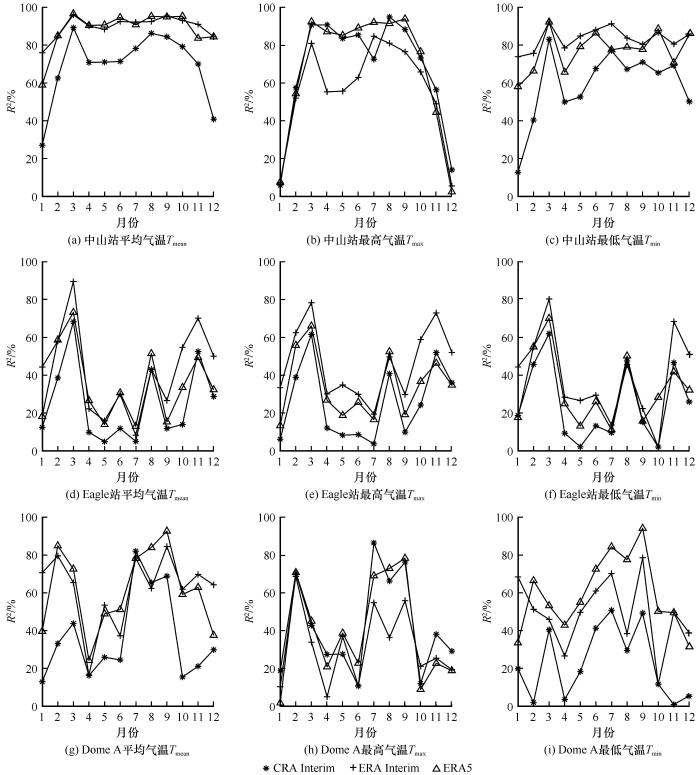
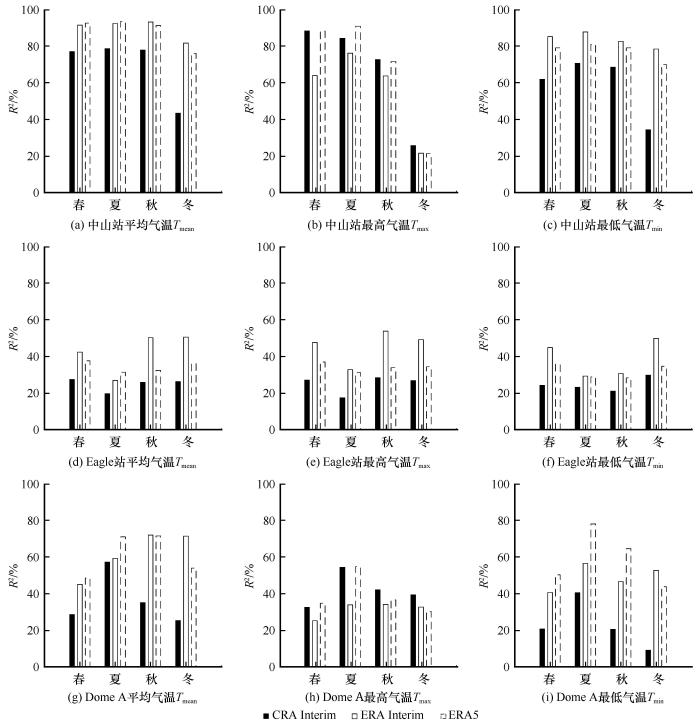
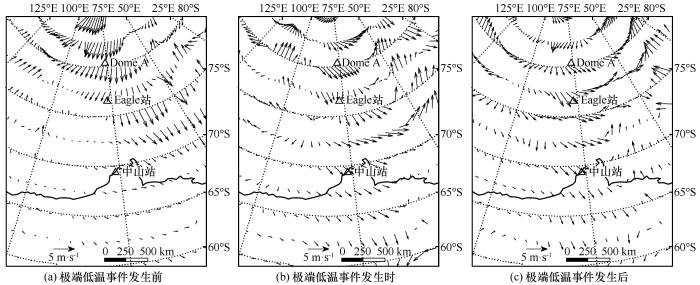
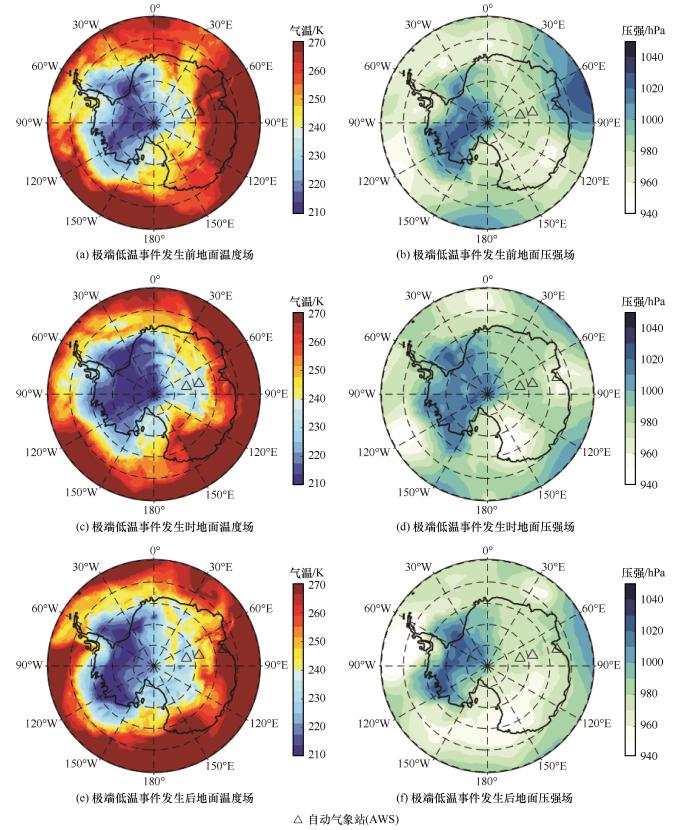
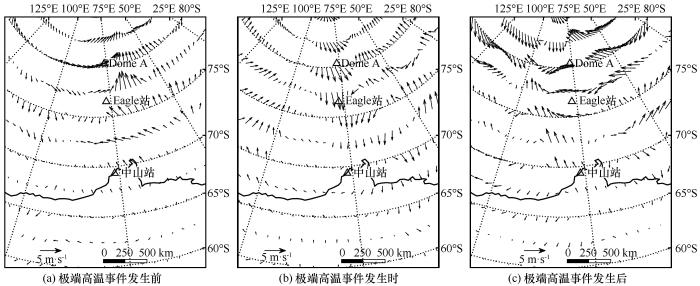
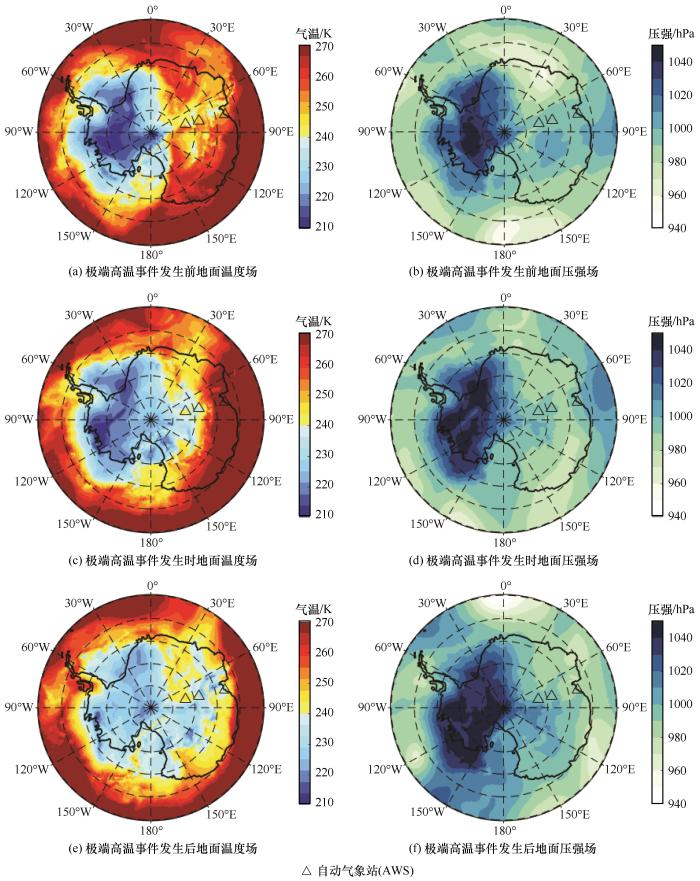

 甘公网安备 62010202000676号
甘公网安备 62010202000676号